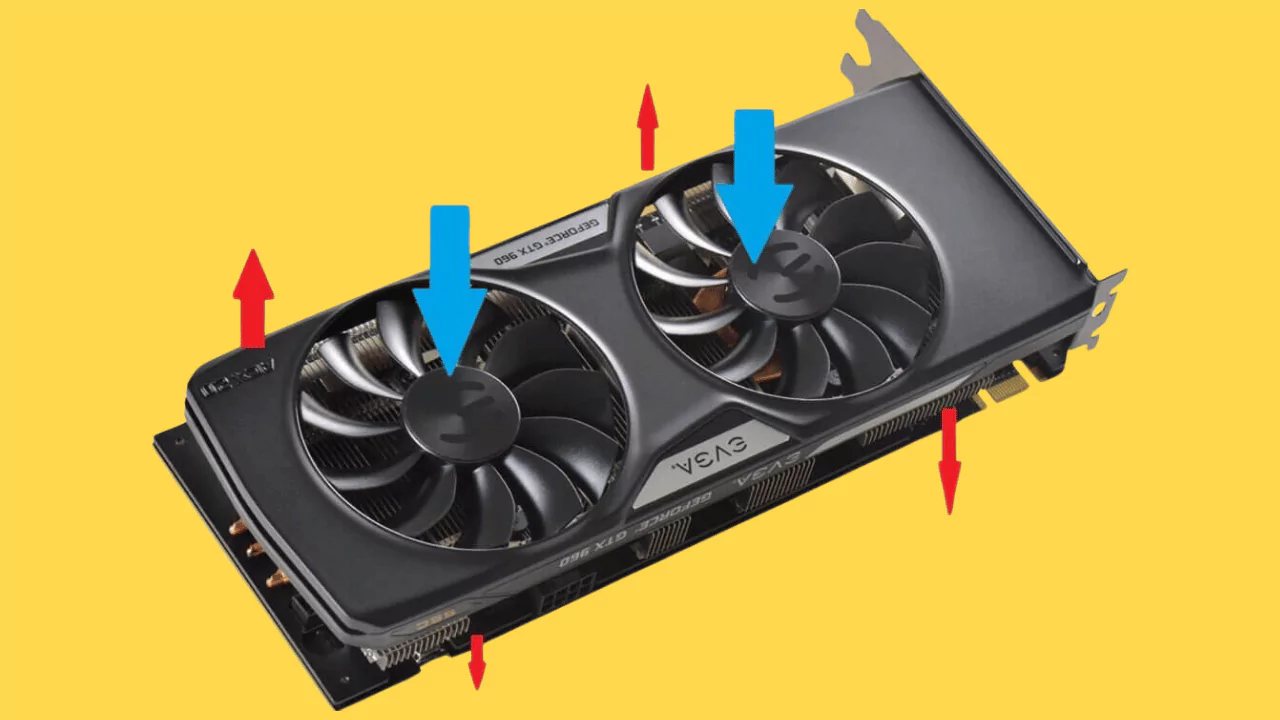GPU fans are typically exhaust fans, which means they expel hot air from the graphics card and the case. However, based on the design and cooling strategy, some GPUs may have extra fans for air intake.
As a general rule, GPU fans push air toward the heatsink. The fan blades move air from the case into the heatsink and out of the case. This helps the GPU’s heat escape, keeping the computer running at its best temperature.
Understanding GPU Fans
GPU fans are the small fans attached to the graphics card, which is the device that processes and displays images on the screen. There are two main types of GPU fans: axial and blower-style.
- Axial fans are the most common type of GPU fans, and they look like regular case fans. They have multiple blades that spin in a circular motion and push air downwards onto the graphics card. They are usually quieter and more efficient than blower-style fans, but they also tend to recirculate hot air inside the case.
- Blower-style fans are less common, and they look like mini jet engines. They have a single fan that spins at a high speed and pushes air sideways through a vent. They are usually louder and less efficient than axial fans, but they also tend to exhaust hot air outside the case.
GPU fans work by creating airflow over the graphics card, which has a metal heatsink that absorbs and dissipates heat. The more airflow the fans create, the cooler the graphics card stays. However, too much airflow can also create noise and dust problems, so it is important to balance the fan speed and noise level.
Airflow and Direction of GPU Fans
The airflow and direction of GPU fans affect the temperatures and performance of the graphics card and the whole system. Generally, there are two ways to orient the GPU fans: intake or exhaust.
Intake
Intake means that the GPU fans draw fresh air from outside the case and blow it onto the graphics card. This helps keep the graphics card cool, but it also increases the temperature inside the case, which can affect other components. Intake is usually preferred for axial fans, as they can benefit from the cooler air.
Exhaust
Exhaust means that the GPU fans draw hot air from inside the case and blow it out of the case. This helps keep the case cool, but it also reduces the airflow over the graphics card, which can affect its cooling. Exhaust is usually preferred for blower-style fans, as they can benefit from the venting.
The best way to determine the airflow and direction of GPU fans is to look at the fan blades’ orientation and the air’s direction. If the fan blades are facing up, then the air is blowing downwards. If the fan blades are facing down, then the air is blowing upwards. If the air is blowing toward the back of the case, then the fan is exhausted. If the air is blowing towards the front of the case, then the fan is intake.
Tips for Optimizing GPU Fan Usage
To get the most out of GPU fans, there are some tips to follow for proper placement and airflow in the system, as well as practical maintenance and longevity.
Proper placement and airflow in the system
The GPU fans should be set up so that they allow the most air to flow over the graphics card with the least amount of blockage and noise. As an example, GPU fans that pull air in should be put at the bottom of the box, where it’s cooler and less dusty. When it comes to GPU fans, they should be put at the top of the case, where the air is cooler and more likely to leave. The GPU fans should also be lined up with the case fans so that they work together to make the airflow smooth and even. Case fans should have an intake at the front and exhaust at the back. Similarly, GPU fans should have an intake at the bottom and an exhaust at the top.
Practical maintenance and longevity
The GPU fans should be cleaned and maintained regularly, as dust and dirt can accumulate and reduce their efficiency and lifespan. To clean the GPU fans, the graphics card should be removed from the system and the fan blades should be gently wiped with a soft cloth or a compressed air can. The fan bearings should also be lubricated with a drop of oil or grease, if possible. To extend the lifespan of the GPU fans, the fan speed should be adjusted according to the temperature and load of the graphics card, using software tools such as MSI Afterburner or EVGA Precision X1. The fan speed should be high enough to keep the graphics card cool, but low enough to reduce noise and wear.







